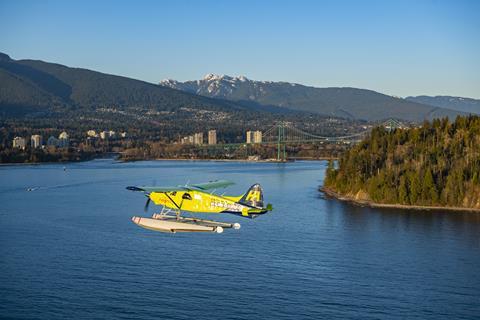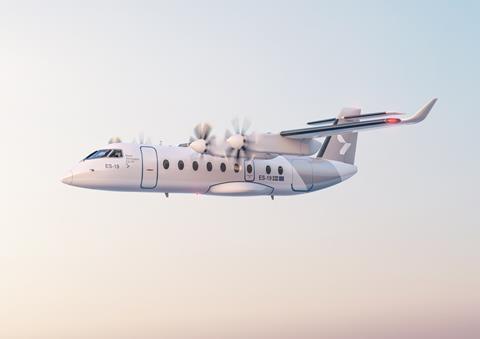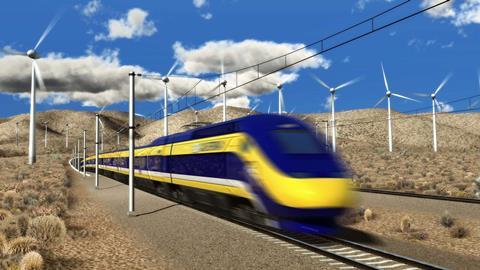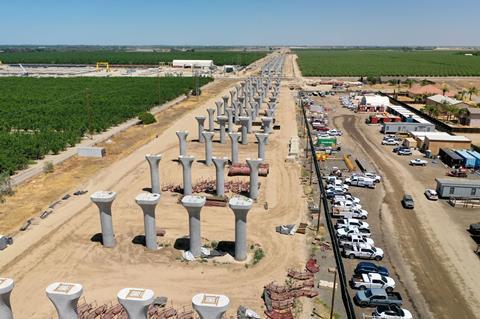When approved by voters in 2008, California’s proposed high-speed rail line was supposed to run the roughly 400-mile distance between Los Angeles and San Francisco by 2020 at a cost of $33 billion.
Already one year past due, government officials now say the bullet train will not be finished until the mid-2030s. Perhaps most startling (or not – its a government-led project), the cost to finish the job has soared up to $100 billion.
Which raises a fair question: What else could have been done with so much time and money?

In earlier decades, there wasn’t a workable and environmentally friendly alternative to high-speed rail.
That is no longer true: rapid battery technology improvements are poised to make viable an unexpected yet superior form of regional transportation: electric aircraft.
Establishing a single high-speed rail line requires governments move mountains of earth and treasure – as well as private homes that stand in the path of grand plans. But a single small regional airline in Vancouver, Canada is working to prove how quickly electric aircraft can be introduced on short-haul air routes.
Just a few years after first flying a modified, electric-powered De Havilland Canada DHC-2 Beaver demonstrator, Harbour aims to become the first airline to carry paying passengers on an electric aircraft, in summer 2022. It will use an upgraded version of its electric floatplane, which will be capable of carrying three to four passengers on flights of about 30min.
That’s a humble start.
But Harbour chief executive Greg McDougall calls the latest configuration of the Beaver “economically viable”. He envisions electrifying the commuter airline’s entire fleet, which includes aircraft as large as 19-passenger DHC-6 Twin Otters.
Harbour is not alone. Other pioneers are working on both electric-retrofit and clean-sheet electric aircraft, such as Eviation’s nine-passenger Alice and Heart Aerospace’s 19-passenger ES-19. They are banking on improvements in battery energy density and continued falling battery prices to make their designs commercially successful.

It’s a bet that’s not hard to understand.
The cost of lithium-ion battery packs declined 89% from 2010 to 2020, according to research service BloombergNEF. That has enabled the emerging economic viability of electric aircraft. What’s more, average battery energy density – the amount of energy stored per kilogram of battery – is increasing an average of 7% each year. More-powerful batteries will enable electric aircraft to fly farther and carry more passengers.
Electric motors are intriguing to regional operators; the devices are mechanically simple and highly energy efficient. That means operational savings on energy and maintenance, which could be captured as profits or used to lower fares.
Discounted prices might enable the market to expand to cost-conscious customers and perhaps, one day, average Americans travelling on vacation. McKinsey & Company estimates electric aircraft could boost the regional aircraft industry to $30 billion in total revenue by 2030, up from about $5 billion today.
When combined with the fact that most regional airline routes are short-legged – for example, 67% of Cape Air’s flights are shorter than 100nm (185km), and all are shorter than 225nm, according to a 2016 study – it doesn’t take much imagination to envision how continued battery improvements could enable electric aircraft to cover most commuter routes flown today. Some advocates think electric aircraft could, even in the short term, be carrying up to 19 passengers on routes up to 500 miles.
Being cheaper to operate, electric aircraft could possibly succeed financially where gas-powered aircraft have not; they could fill in the countless US regional routes abandoned in recent decades by small airlines that either merged or failed outright.

Such routes would put electric aircraft in direct competition with high-speed rail – often billed as best for trips “too short to fly, and too far to drive”. Electric aircraft could be connecting small cities in much less time than governments might hope to expand high-speed rail.
That is because high-speed rail lines barely exist in the USA, other than the moderately fast Amtrak Acela service between Boston and Washington, DC. Passenger trains once did connect many US cities, even smaller ones, particularly those in industrial regions. But last century, as US drivers took to newly built interstate highways, many passenger rail companies failed. Tracks were abandoned or taken over by freight companies. Many were converted into cycling trails.
For that reason, high-speed tracks have to be built from scratch in the USA, at great political and monetary expense.
Take, for example, California’s failure to build the first “easy” section of the aforementioned high-speed rail line, a 171-mile link between farm towns Bakersfield and Merced. The rail authority has struggled to get farmers to sell their land for the tracks. It has resorted to using “eminent domain”, an unpopular US legal process for condemning and seizing land, but still doesn’t have all parcels required to finish the route. The unfinished section of rail is billions of dollars over budget, has been reduced to a single, one-directional track and is projected to be finished a decade late. Will it be finished at all?

In contrast, electric aircraft do not require land acquisition and those inherent legal issues. Electric air travel also has fewer “sunk costs” – major upfront, unrecoverable expenses, such as for laying new track. If an airline route fails due to lack of customer interest, aircraft and ground equipment can be moved to cities with more demand.
High-speed rail advocates often point out that bullet trains can drop off hundreds of passengers directly into downtown areas. That convenience is great for tourists and some business travellers. But most US travellers are not tourists. And many Americans do not live in downtowns due to high rent. They live in suburbs. Many do not want to travel between downtowns.
Cities that often end up on proposed US high-speed rail network maps – major urban centres such as Chicago, Los Angeles, New York and the San Francisco Bay Area – are losing population, largely due to the high cost of real estate, according to 2020 census estimates. Covid-19 accelerated that trend. Suburbs, followed by midsize and small cities, are the fastest growing.
Here, too, electric aircraft have an advantage.
The USA has more than 5,000 airports, thanks partly to the Federal Airport Act of 1946. Because of that New Deal-esque public works project, more than half of all Americans live within a 16min drive of an airport, and some 90% live within a 30min drive of a regional airport.
Given these advantages, US federal, state and local governments should throw support behind electric regional aircraft. Funding or tax incentives for electric aircraft charging infrastructure (as also proposed for the electric vehicle industry) would accelerate industry adoption. The Federal Aviation Administration should also resist attempts by local authorities to shut down small airports in favour of real estate development. Experimental aircraft, such as NASA’s electric-powered X-57 Maxwell demonstrator, should be encouraged and funded.
As the private aerospace industry is already funding much of the electric aircraft revolution, governments would not need spend tens of billions of dollars on these projects to accelerate the sector.
Indeed, if governments helped fund charging infrastructure at regional and municipal airport assets they already own, the industry could greatly benefit. Compared to the hundreds of billions of dollars, legal hurdles, and decades of manpower that a national high-speed rail network requires, establishing electric regional aircraft routes should be an easier lift.
Topics
Why visionaries think small electric aircraft can revolutionise regional air travel
- 1
- 2
 Currently reading
Currently readingThe USA should invest in electric regional aircraft – not high-speed rail






























